Top ratings
Get free trial access now Try first, then study!
4.92/5.0 (from 386 Trusted Shops Reviews )
4.9/5.0
- Google reviews

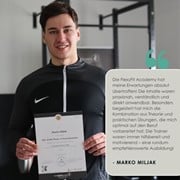

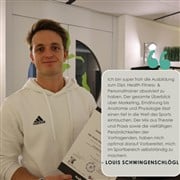
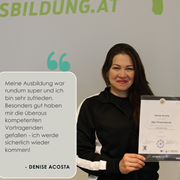


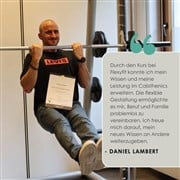

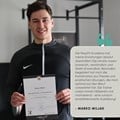
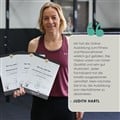
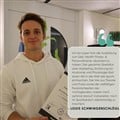

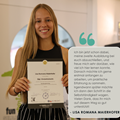



starting at €1.990,- | Online Course
» Our Course Packages
Flexible learning - our possible learning options for the course:
Important informations
Recognized & Certified
Our graduates, partners & friends say
Our team will be happy to advise you at any time by phone, chat or in person
You are looking for an online distance-learning course for becoming a certified fitness coach and personal trainer? Then our Health & Fitness Personal Trainer course is for you!
As a comprehensive training that builds on our Fitness Trainer A-License, this course goes beyond working in a fitness studio or gym. Using personalized training concepts and one-on-one coaching you can help your clients achieve a better state of fitness and well-being.
The Health & Fitness Personal Trainer course includes the Fitness Trainer A-License, so you will have two certifications at the end.
Extent of learning
832 E
EQF level
The training is based on EQF level 4 »
Course start
Possible immediately
Learning variant
Online Courses

Fitness trainers/personal trainers support their clients in achieving their desired goals. As a personal trainer, you support your clients with nutrition tips and the creation of individual training plans. You motivate your clients and make sure that the workouts they perform lead them to their training goals successfully.
If you want to build on your fitness trainer course or want to reorient yourself professionally, you can put your knowledge into practice and start your career with our flexible online personal trainer course within a short time!
This training includes all contents of the Fitness Trainer B-Licenseand the Fitness Trainer A-License. Building on these modules, participants in the Health Fitness & Personal Trainer module gain insights into the most diverse training methods. From differentiated and free weight training to functional training and HIT high intensity training. Participants are comprehensively prepared for the work in fitness studios, sports and wellness hotels, physiotherapy centres, health facilities or on a self-employed basis.
Our certificates are accepted worldwide and are issued in different versions. On request, you can receive our certificate in several languages (DE, EN, ES), with country-specific information as well as with and without imprint of the grades.
These versions are all available for free download from your online campus. In addition you receive a certificate of your choice printed on special paper with relief printing.
The following certificates (in several languages DE, EN, ES) will be awarded:
We are happy to help. Contact us via phone, e-mail or online chat. Alternatively, you may find the answer to your question in our general FAQ or Health Fitness & Personal Trainer FAQ.
You start your training with the basic module Sports Competence. You are taught theoretical knowledge in eight different subjects through videos and scripts. At the end of each subject you take a short multiple-choice online exam to test your understanding.
The completion of the basic module Sports Competence is followed by your professional specialization, where you study your chosen subject.
Since our training courses are very flexible, the duration depends a lot on your own learning initiative, the amount of time you spend each week and your prior knowledge.
You learn at your own pace - whenever and wherever you want. Your Academy account accompanies you on your computer, tablet or smartphone and includes everything you need to complete the training.
You have access to a large number of full HD learning videos in which our first-class instructors teach you the training content. In addition, you can also read the same content in our scripts and presentations.
You work on your grade with practical sessions and voluntary additional tasks that are available to you. These include training logs, written essays and filming of exercises.
As a part of your training you take multiple-choice online exams as well as an online final exam and two final exams in presence.
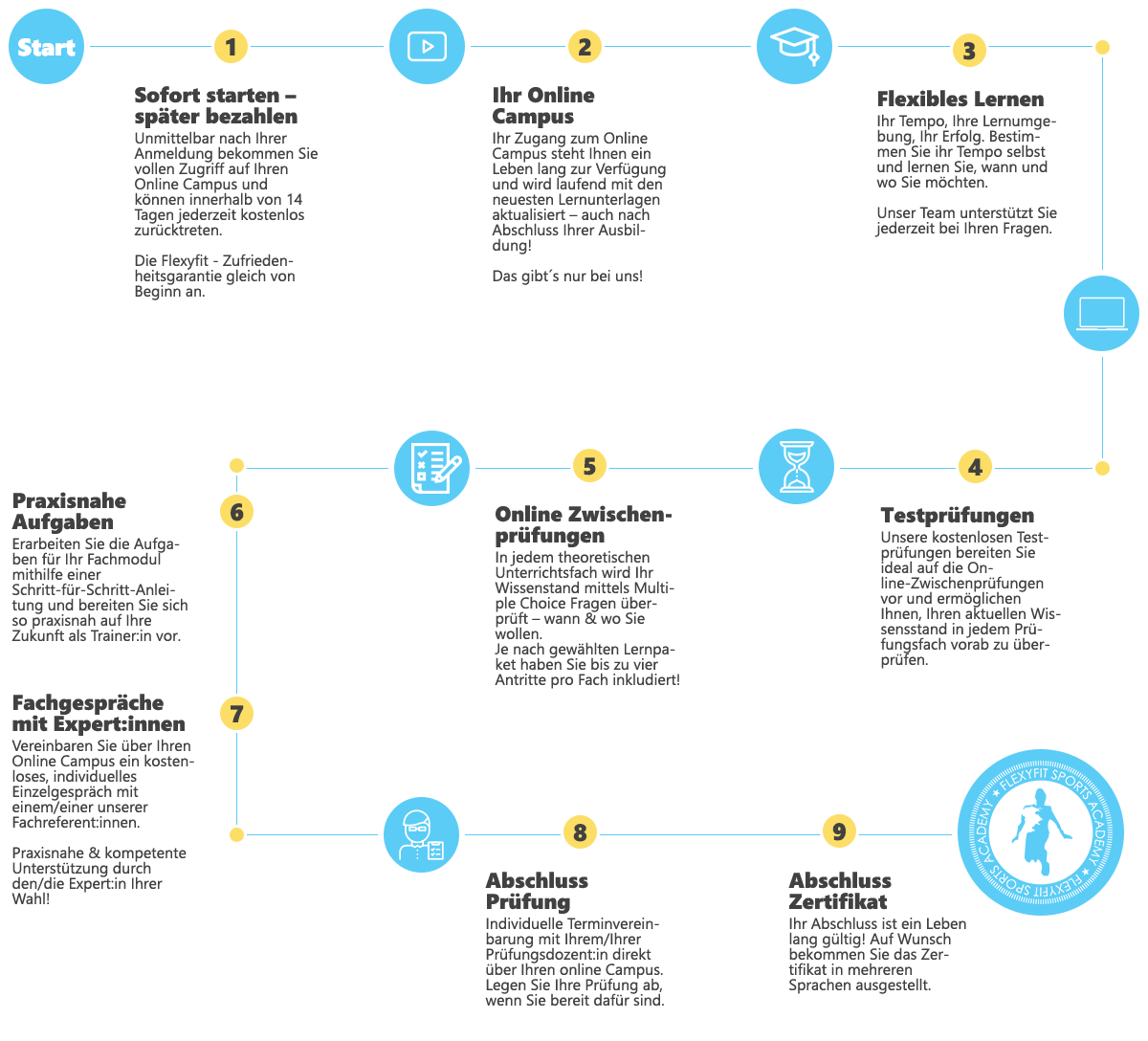
Extent of learning
200
Sports expertise
507
eLearning | Presence
18
Literature research
90
Practical realization
17
Additional tasks & examinations
This course is ideal for educational leave. Individual assessment and approval is carried out by the respective funding body. We will be happy to provide you with detailed information on the duration and procedure of educational leave. Contact us to arrange a consultation!
Participation in the face-to-face webinars is mandatory for educational leave and must be proven to the AMS. The participant is responsible for requesting confirmation of attendance. Confirmation of attendance of the face-to-face webinar will only be issued during each webinar if requested by the participant.
Show all chapters of the subjects

We educate the best trainers in the fitness branch. From start to finish of the education - and beyond!- we support and guide our students.
Functional anatomy is a foundation necessary for all trainers in exercise, fitness and sports. This subject provides a comprehensive introduction to the anatomy of the human body and a wellspring of important knowledge.
The course is constructed to present the information in an interesting and comprehensible manner and features different learning approaches appropriate for Fitness and Personal Trainers.
The goal is, to understand the relationship between movement patterns, the human body and relevant anatomical terminology.
Show chapter

Show chapter

Show chapter

More and more companies are integrating Corporate Wellness and similar health initiatives into their employee benefits packages. By doing so they promote the health and well-being of their employees, reducing the incidence of sick-leave and building healthier, stronger team dynamics.
Exactly why such initiatives are important is discussed in this introduction to the concept, as well as challenges that such initiatives face including organisational dysfunction.
Participants also learn about the advantages of corporate wellness and some trusted approaches and tools for finding and working with a company.
We offer suggestions on how to approach companies about Corporate Wellness, how to develop a corporate wellness concept and important organisational points to consider.
Participants will be exposed to some practical examples and will have the possiblity to perform group work on the topic.
Show chapter

The unit on Marketing and Customer Interaction gives participants some insight into identifying, working with and marketing to their ideal customer. This is one of the most useful units for the aspiring trainer, as it helps them identify their place in the market, which makes for a more successful career start.
We begin by taking a look at Marketing itself to understand exactly what it is and of what relevance it has for personal trainers.
Important basic concepts such as USP, positioning, target market, etc. are introduced and different models from marketing such as the SMART Formula, marketing mix (7Ps) and more are explained.
The communication between trainer and client is also addressed in this unit. Various aspects of communication theory and some guidelines for successful communication are covered.
Upon completion of this subject, participants are able to develop marketing strategies for their product and/or services, ready to position themselves in a market rich in variety and full of possibility!
Show chapter

A working understanding of human physiology and therefore the relationships between the various functions of the human body is crucial for anyone working in the exercise and fitness field. It is a requisite knowledge for the sufficient practice of their profession.
This course makes the relationships within the human organism graspable for everyone. Take a deep-dive into the human body and learn the functions of our organism for your new profession in fitness.
In this subject you will get a close look at energy metabolism needed for muscle activation, the circulatory system and the pulmonary system.
Any high quality education in fitness and exercise begins with the foundations of anatomy and physiology.
Show chapter

In this unit participants are prepared for successful communication with their clients on every level. In addition, we take a look at how the trainer or coach can go about dealing with their own goals and motives, which will in turn help them better understand their clients.
The right goal-setting and the proper approach to feedback are an important parts of this unit.
The way we manage stress as trainers and with our clients and a variety of learning strategies are explored so these skills can be integrated into your professional approach.
Show chapter

In this introduction to training theory we look at the foundations of training plan creation and management, including the principles of training, training methodology and factors that influence sports performance.
Because performance capacity, performance diagnostics, training and competition are so interrelated, they are covered together in this unit.
The second half of this unit Im zweiten Teil der Trainingslehre wird das Training als komplexer Handlungsprozess und im Zusammenhang mit Planung, Ausführung und Evaluation definiert und bewertet.
Ein wichtiger Teil der Trainingslehre ist nach wie vor die Trainingsplangestaltung, die mit Beispielen über die Möglichkeiten einer Trainingsplangestaltung praktisch vermittelt werden.
Um das Thema der Trainingswissenschaft zu vertiefen, laden wir regelmäßig internationale Top-Dozenten wie Univ. Prof. Dr. Paul Haber und Prof.em. Dr.phil. Dr.med. Dr. hc Jürgen Weineck zu uns in die Academy ein.
Unter anderem sind sie für die Bücher "Optimales Training" (Jürgen Weineck) und "Leistungsphysiologie" (Paul Haber) in der Trainingswissenschaft bekannt.
Show chapter
Show all chapters of the subjects

Equipment-assisted strength training is a central component of your fitness trainer B license training. In this module, you will learn how to plan and instruct strength exercises on fitness equipment in a safe, effective and target group-oriented manner. The content is practical and theoretically sound - and can be completed flexibly online as part of your trainer license.
Equipment-assisted strength training is training with machines or guided equipment that is often used in the gym or in rehabilitation. It enables targeted muscle loading, supports safe movement and is particularly suitable for beginners or older people.
As a prospective fitness trainer with a B license, you should have a sound knowledge of training methodology, equipment settings, exercise selection and correction techniques. This module teaches you precisely this content and prepares you optimally for your work in the gym or in personal training.
Are you completing your fitness trainer B license training online? Perfect! This module is fully integrated into our digital learning environment. You benefit from flexible learning times, digital learning scripts and video analysis to learn the equipment training from anywhere.
This module is part of your fitness trainer B license training - whether online or in person. Start at any time and systematically build up your specialist knowledge in the field of strength training.
Find out now without obligation
Is the module suitable for beginners?
Yes, the module is ideal for beginners and provides practical knowledge.
How does the online training work?
You receive access to our learning platform, work on content at your own pace and can take part in practical workshops if required.
Who can complete the course?
Anyone aged 18 or over who is interested in sport - previous knowledge is helpful, but not essential.
Show chapter

Show chapter
Show all chapters of the subjects

Show chapter

Show chapter

Show chapter

In functional training several muscles are strengthened at the same time. Entire muscle groups/muscle chains are worked out. It is mainly focused on the coordination of the muscles, the interaction of the muscles with each other, the economization of the movements and the stability of the core.
Functional strength training is highly important because it can be integrated into daily life and is applicable to all sports. It is used in recreational and leisure sports, in competitive sports, in rehabilitation training and in preventive training. In addition, it can be practiced at any age.
Functional strength training involves training with unstable equipment and with the own body weight.
In this unit, our participants learn how to work with various equipment, such as the sling trainer, the pezzi ball, etc. and how to use them in functional training. They are shown different body weight exercises, different muscle chains and they are taught and how to train them selectively.
Show chapter

Show chapter

Show chapter
Show all chapters of the subjects

Back pain and shoulder pain are among the most common problems for practitioners of strength training. In order to make an effort to combat these issues, a personal trainer has to understand potential causes that can lead to these problems.
A precise diagnosis can only be provided by a medical professional, obviously. In that case, it is certainly important that the personal trainer understand any such diagnoses and develop an optimal strength training programthat is appropriate for any previous condition or injury, or for the explicit purpose of preventing or avoiding problems for which the client is predisposed.
Theoretical content will revisit anatomy with these issues in mind and practical content will include exercises for practical application of knowledge. It will be carried out in two sessions.
Show chapter

This course subject is a continuation of Strength Training with Free Weights 1, which is covered in the Fitness Trainer course. Additional exercises will be introduced for back, chest, shoulder, arm that were not covered in the first part.
A special focus is placed on thebarbellin this group of exercises. In comparison with the first part, the exercises in part 2 tend to display increased complexity and require not only more strength but more developedfocus and coordination skills.
The higher complexity of the exercises mean that such training is more challenging, and variations can train multiple muscle groups at once.
For examples, theOlympic weightlifting movements such as clean and jerk and snatch are introduced.
In addition, some variations of exercises are explored with a methodoligical approach for building variations.
Show chapter

This course topic comprises two sections:
We start with the concept of a functional warm-up approach to this first part of any training session.
We will compare different strategies for warming up and the reasons for warming up, clarifying the effects of warm-up and their relevance to training. The order of individual elements of a warm-up is also covered. Another aspect covered in this unit is novel functional warm-up practices, such as with the use of a foam roller and a variety of mobilization exercises.
The second unit covers the topic of functional training.
We review and answer open questions about the foundations of functional training. We look at numerous functional exercises in closer detail, with and without additional equipment, and work through them in practical execution and discussion. The structure and instruction of HIIT sessions (High Intensity Interval Training) is also touched upon, including a discussion as to how they can be most effectively integrated into group training sessions.
Show chapter

The training approach known as High Intensity Training (HIT) is not to be confused with the similar-sounding High Intensitiy Intervall Training (HIIT). The latter is an approach to strength-endurance or specialized endurance training. HIT, on the other hand, is a special form Hypertrophy Training that is intended to increase muscle mass and strength.
HIT has its origins in bodybuilding and is a training method that can be a very effective and effecient way to train the musculature.
In fast-paced times like ours, the time factor can play a big role among clients and too-long sessions can be a reason to avoid or cease training altogether. One of the most advantageous qualities of a training program can there be that it provides the most effective training effect in the least amount of time.
The parameters of a HIT training session and the important factors to consider are elucidated in this module. The participant is encouraged to experiment, insofar as their training level permits, with the method of HIT training in order to gain practical understanding of the approach.
Show chapter

In this unit covering One2One training the focus is on stretching and mobilization, and how you as a trainer can use this opportunity to learn and make evaluations about your client during this time.
The functional movement analysis, known also as a screen or the FMS is introduced as one possible approach to gain some insight into a trainees current physical state. As such, it serves as one way to gather "actual state" metrics.
Mobility, flexibility and a healthy and balanced range of motion is an important component of every sport and physical practice, and it can have a huge influence on liklihood of injury or overall performance. An appropriate stretching session can increase range of motion during exercise during training exercises, leading to better training adaptations. A post-training stretching routine can aid in regeneration and the maintainance of existing flexibility levels.
The palette of stretching types are introduced in this module, with various stretching techniques and their practical application. The use of a foam roller for certain methods is included.
Additionally, the crucial concepts of spotting and manual assistance are explained and put in practice. A discussion of important considerations for this close work with clients is carried out.
Show chapter

Show chapter
The Health Fitness & Personal Trainer A-Licence course is state-approved in Germany via the ZFU (Approval No.: 7406522), including the specialist seminar on sports competence (Approval No.: 7324018c). The ZFU is the central office for distance learning in Germany and works on the basis of the Distance Learning Protection Act (FernUSG). It decides on the approval of distance learning courses throughout Germany in order to guarantee a professionally correct and overall professional distance learning course.
As a recognised institution in adult education, our curricula are regularly evaluated and recognised by state institutions and funding bodies. We constantly strive to exceed current quality standards in order to guarantee you the best possible training. See our certifications for yourself.
At Flexyfit Sports Academy you have various opportunities to support your education. There are different scholarship programs at the state and EU levels, as well as tax incentives that serve as a basis.
Please note, however, that the decision on the assignment and extent of the scholarship is the absolute responsibility of the respective funding agency.
We are happy to help you finding a suitable finacial support and provide you with all the course information you need for a scholarship application. You must submit the application itself to the relevant funding agencies.
You can find an overview of the most important funding agencies here.
Yes, the majority of our courses are suitable for educational leave
If you wish to study without quitting your job, you can arrange an educational leave with your employer. In this case you will be released from work for the duration of the course.
Plan your educational leave with us now! We are happy to help you determine your individual training needs in a personal, non-binding consultation .
Please note that this is a general summary and it is advised that further details and conditions be obtained from the appropriate agencies or authorities.
For an educational leave, the approval of your employer is required. You must submit the educational plans issued by us, which include a volume of 20 hours per week for a full-time educational leave or at least 10 hours per week for a part-time educational leave.
In addition, it is necessary to provide regular evidence of the progress of your training, for example through examinations or attendance certificates issued by us.
Fitness and personal trainers help clients achieve their desired goals. Personal trainers create individual training plans and optimise the training of their clients, and support them with nutrition tips. As a fitness and personal trainer, you are the client's motivator, so to speak, and make sure that the training sessions fit perfectly with the personal goals.
Personal training is one-to-one training, i.e. direct contact with clients. The training does not necessarily have to take place in a fitness studio. To ensure that you are perfectly prepared for one-to-one training with your clients, our training focuses on, among other things, movement sequences, training instructions as well as recognising and safely correcting mistakes and hands-on techniques in dealing with clients. After completing your training, you will have the opportunity to work both on a self-employed basis and as an employee in fitness studios, sports and leisure facilities or health care facilities. You will also gain extensive knowledge about creative ways of organising training sessions using a wide range of aids.
The salary of a fitness trainer varies based on the type of employment. In an employment position one can expect an entry-level salary of around € 18.600 to € 21.900 gross per year. With increasing professional experience, earnings rise to approximately € 23,200 to € 25,000 annually.
For those who are self employed the income depends on the number of clients and the set prices. The cost of renting space must also be considered, unless the trainer opts for home visits and outdoor training.
Fitness trainers find employment in various fields. They often work in fitness studios, either as permanent employees or independent contractors. Additionally, they are also needed in wellness establishments such as hotels or health centers or sports clubs.
Many fitness trainers aspire to be self employed as personal trainers, leading to a variety of potential work locations. Besides having their own facilities, popular options include outdoor training or conducting home visits for clients. Some fitness trainers may also arrange agreements with fitness centers to use their facilities in exchange for rent.
Establishing a personal fitness studio has become more challenging due to growing competition. As a result, many fitness trainers opt for alternative career paths, such as corporate wellness or sports development. In the latter, they can provide consultancy for designing fitness centers, sports fields, and sports halls.
On our platform Sportkarriere we regularly post job listings from fitness studios. From there, you have the opportunity to directly apply for positions as a fitness trainer, branch manager, instructor, or studio staff member.

Fitness trainers/personal trainers support their clients in achieving their desired goals. As a personal trainer, you support your clients with nutrition tips and the creation of individual training plans. You motivate your clients and make sure that the workouts they perform lead them to their training goals successfully.
If you want to build on your fitness trainer course or want to reorient yourself professionally, you can put your knowledge into practice and start your career with our flexible online personal trainer course within a short time!
This training includes all contents of the Fitness Trainer B-Licenseand the Fitness Trainer A-License. Building on these modules, participants in the Health Fitness & Personal Trainer module gain insights into the most diverse training methods. From differentiated and free weight training to functional training and HIT high intensity training. Participants are comprehensively prepared for the work in fitness studios, sports and wellness hotels, physiotherapy centres, health facilities or on a self-employed basis.
Our certificates are accepted worldwide and are issued in different versions. On request, you can receive our certificate in several languages (DE, EN, ES), with country-specific information as well as with and without imprint of the grades.
These versions are all available for free download from your online campus. In addition you receive a certificate of your choice printed on special paper with relief printing.
The following certificates (in several languages DE, EN, ES) will be awarded:
We are happy to help. Contact us via phone, e-mail or online chat. Alternatively, you may find the answer to your question in our general FAQ or Health Fitness & Personal Trainer FAQ.
You start your training with the basic module Sports Competence. You are taught theoretical knowledge in eight different subjects through videos and scripts. At the end of each subject you take a short multiple-choice online exam to test your understanding.
The completion of the basic module Sports Competence is followed by your professional specialization, where you study your chosen subject.
Since our training courses are very flexible, the duration depends a lot on your own learning initiative, the amount of time you spend each week and your prior knowledge.
You learn at your own pace - whenever and wherever you want. Your Academy account accompanies you on your computer, tablet or smartphone and includes everything you need to complete the training.
You have access to a large number of full HD learning videos in which our first-class instructors teach you the training content. In addition, you can also read the same content in our scripts and presentations.
You work on your grade with practical sessions and voluntary additional tasks that are available to you. These include training logs, written essays and filming of exercises.
As a part of your training you take multiple-choice online exams as well as an online final exam and two final exams in presence.

Extent of learning
200
Sports expertise
507
eLearning | Presence
18
Literature research
90
Practical realization
17
Additional tasks & examinations
This course is ideal for educational leave. Individual assessment and approval is carried out by the respective funding body. We will be happy to provide you with detailed information on the duration and procedure of educational leave. Contact us to arrange a consultation!
Participation in the face-to-face webinars is mandatory for educational leave and must be proven to the AMS. The participant is responsible for requesting confirmation of attendance. Confirmation of attendance of the face-to-face webinar will only be issued during each webinar if requested by the participant.
Show all chapters of the subjects

We educate the best trainers in the fitness branch. From start to finish of the education - and beyond!- we support and guide our students.
Functional anatomy is a foundation necessary for all trainers in exercise, fitness and sports. This subject provides a comprehensive introduction to the anatomy of the human body and a wellspring of important knowledge.
The course is constructed to present the information in an interesting and comprehensible manner and features different learning approaches appropriate for Fitness and Personal Trainers.
The goal is, to understand the relationship between movement patterns, the human body and relevant anatomical terminology.
Show chapter

Show chapter

Show chapter

More and more companies are integrating Corporate Wellness and similar health initiatives into their employee benefits packages. By doing so they promote the health and well-being of their employees, reducing the incidence of sick-leave and building healthier, stronger team dynamics.
Exactly why such initiatives are important is discussed in this introduction to the concept, as well as challenges that such initiatives face including organisational dysfunction.
Participants also learn about the advantages of corporate wellness and some trusted approaches and tools for finding and working with a company.
We offer suggestions on how to approach companies about Corporate Wellness, how to develop a corporate wellness concept and important organisational points to consider.
Participants will be exposed to some practical examples and will have the possiblity to perform group work on the topic.
Show chapter

The unit on Marketing and Customer Interaction gives participants some insight into identifying, working with and marketing to their ideal customer. This is one of the most useful units for the aspiring trainer, as it helps them identify their place in the market, which makes for a more successful career start.
We begin by taking a look at Marketing itself to understand exactly what it is and of what relevance it has for personal trainers.
Important basic concepts such as USP, positioning, target market, etc. are introduced and different models from marketing such as the SMART Formula, marketing mix (7Ps) and more are explained.
The communication between trainer and client is also addressed in this unit. Various aspects of communication theory and some guidelines for successful communication are covered.
Upon completion of this subject, participants are able to develop marketing strategies for their product and/or services, ready to position themselves in a market rich in variety and full of possibility!
Show chapter

A working understanding of human physiology and therefore the relationships between the various functions of the human body is crucial for anyone working in the exercise and fitness field. It is a requisite knowledge for the sufficient practice of their profession.
This course makes the relationships within the human organism graspable for everyone. Take a deep-dive into the human body and learn the functions of our organism for your new profession in fitness.
In this subject you will get a close look at energy metabolism needed for muscle activation, the circulatory system and the pulmonary system.
Any high quality education in fitness and exercise begins with the foundations of anatomy and physiology.
Show chapter

In this unit participants are prepared for successful communication with their clients on every level. In addition, we take a look at how the trainer or coach can go about dealing with their own goals and motives, which will in turn help them better understand their clients.
The right goal-setting and the proper approach to feedback are an important parts of this unit.
The way we manage stress as trainers and with our clients and a variety of learning strategies are explored so these skills can be integrated into your professional approach.
Show chapter

In this introduction to training theory we look at the foundations of training plan creation and management, including the principles of training, training methodology and factors that influence sports performance.
Because performance capacity, performance diagnostics, training and competition are so interrelated, they are covered together in this unit.
The second half of this unit Im zweiten Teil der Trainingslehre wird das Training als komplexer Handlungsprozess und im Zusammenhang mit Planung, Ausführung und Evaluation definiert und bewertet.
Ein wichtiger Teil der Trainingslehre ist nach wie vor die Trainingsplangestaltung, die mit Beispielen über die Möglichkeiten einer Trainingsplangestaltung praktisch vermittelt werden.
Um das Thema der Trainingswissenschaft zu vertiefen, laden wir regelmäßig internationale Top-Dozenten wie Univ. Prof. Dr. Paul Haber und Prof.em. Dr.phil. Dr.med. Dr. hc Jürgen Weineck zu uns in die Academy ein.
Unter anderem sind sie für die Bücher "Optimales Training" (Jürgen Weineck) und "Leistungsphysiologie" (Paul Haber) in der Trainingswissenschaft bekannt.
Show chapter
Show all chapters of the subjects

Equipment-assisted strength training is a central component of your fitness trainer B license training. In this module, you will learn how to plan and instruct strength exercises on fitness equipment in a safe, effective and target group-oriented manner. The content is practical and theoretically sound - and can be completed flexibly online as part of your trainer license.
Equipment-assisted strength training is training with machines or guided equipment that is often used in the gym or in rehabilitation. It enables targeted muscle loading, supports safe movement and is particularly suitable for beginners or older people.
As a prospective fitness trainer with a B license, you should have a sound knowledge of training methodology, equipment settings, exercise selection and correction techniques. This module teaches you precisely this content and prepares you optimally for your work in the gym or in personal training.
Are you completing your fitness trainer B license training online? Perfect! This module is fully integrated into our digital learning environment. You benefit from flexible learning times, digital learning scripts and video analysis to learn the equipment training from anywhere.
This module is part of your fitness trainer B license training - whether online or in person. Start at any time and systematically build up your specialist knowledge in the field of strength training.
Find out now without obligation
Is the module suitable for beginners?
Yes, the module is ideal for beginners and provides practical knowledge.
How does the online training work?
You receive access to our learning platform, work on content at your own pace and can take part in practical workshops if required.
Who can complete the course?
Anyone aged 18 or over who is interested in sport - previous knowledge is helpful, but not essential.
Show chapter

Show chapter
Show all chapters of the subjects

Show chapter

Show chapter

Show chapter

In functional training several muscles are strengthened at the same time. Entire muscle groups/muscle chains are worked out. It is mainly focused on the coordination of the muscles, the interaction of the muscles with each other, the economization of the movements and the stability of the core.
Functional strength training is highly important because it can be integrated into daily life and is applicable to all sports. It is used in recreational and leisure sports, in competitive sports, in rehabilitation training and in preventive training. In addition, it can be practiced at any age.
Functional strength training involves training with unstable equipment and with the own body weight.
In this unit, our participants learn how to work with various equipment, such as the sling trainer, the pezzi ball, etc. and how to use them in functional training. They are shown different body weight exercises, different muscle chains and they are taught and how to train them selectively.
Show chapter

Show chapter

Show chapter
Show all chapters of the subjects

Back pain and shoulder pain are among the most common problems for practitioners of strength training. In order to make an effort to combat these issues, a personal trainer has to understand potential causes that can lead to these problems.
A precise diagnosis can only be provided by a medical professional, obviously. In that case, it is certainly important that the personal trainer understand any such diagnoses and develop an optimal strength training programthat is appropriate for any previous condition or injury, or for the explicit purpose of preventing or avoiding problems for which the client is predisposed.
Theoretical content will revisit anatomy with these issues in mind and practical content will include exercises for practical application of knowledge. It will be carried out in two sessions.
Show chapter

This course subject is a continuation of Strength Training with Free Weights 1, which is covered in the Fitness Trainer course. Additional exercises will be introduced for back, chest, shoulder, arm that were not covered in the first part.
A special focus is placed on thebarbellin this group of exercises. In comparison with the first part, the exercises in part 2 tend to display increased complexity and require not only more strength but more developedfocus and coordination skills.
The higher complexity of the exercises mean that such training is more challenging, and variations can train multiple muscle groups at once.
For examples, theOlympic weightlifting movements such as clean and jerk and snatch are introduced.
In addition, some variations of exercises are explored with a methodoligical approach for building variations.
Show chapter

This course topic comprises two sections:
We start with the concept of a functional warm-up approach to this first part of any training session.
We will compare different strategies for warming up and the reasons for warming up, clarifying the effects of warm-up and their relevance to training. The order of individual elements of a warm-up is also covered. Another aspect covered in this unit is novel functional warm-up practices, such as with the use of a foam roller and a variety of mobilization exercises.
The second unit covers the topic of functional training.
We review and answer open questions about the foundations of functional training. We look at numerous functional exercises in closer detail, with and without additional equipment, and work through them in practical execution and discussion. The structure and instruction of HIIT sessions (High Intensity Interval Training) is also touched upon, including a discussion as to how they can be most effectively integrated into group training sessions.
Show chapter

The training approach known as High Intensity Training (HIT) is not to be confused with the similar-sounding High Intensitiy Intervall Training (HIIT). The latter is an approach to strength-endurance or specialized endurance training. HIT, on the other hand, is a special form Hypertrophy Training that is intended to increase muscle mass and strength.
HIT has its origins in bodybuilding and is a training method that can be a very effective and effecient way to train the musculature.
In fast-paced times like ours, the time factor can play a big role among clients and too-long sessions can be a reason to avoid or cease training altogether. One of the most advantageous qualities of a training program can there be that it provides the most effective training effect in the least amount of time.
The parameters of a HIT training session and the important factors to consider are elucidated in this module. The participant is encouraged to experiment, insofar as their training level permits, with the method of HIT training in order to gain practical understanding of the approach.
Show chapter

In this unit covering One2One training the focus is on stretching and mobilization, and how you as a trainer can use this opportunity to learn and make evaluations about your client during this time.
The functional movement analysis, known also as a screen or the FMS is introduced as one possible approach to gain some insight into a trainees current physical state. As such, it serves as one way to gather "actual state" metrics.
Mobility, flexibility and a healthy and balanced range of motion is an important component of every sport and physical practice, and it can have a huge influence on liklihood of injury or overall performance. An appropriate stretching session can increase range of motion during exercise during training exercises, leading to better training adaptations. A post-training stretching routine can aid in regeneration and the maintainance of existing flexibility levels.
The palette of stretching types are introduced in this module, with various stretching techniques and their practical application. The use of a foam roller for certain methods is included.
Additionally, the crucial concepts of spotting and manual assistance are explained and put in practice. A discussion of important considerations for this close work with clients is carried out.
Show chapter

Show chapter
The Health Fitness & Personal Trainer A-Licence course is state-approved in Germany via the ZFU (Approval No.: 7406522), including the specialist seminar on sports competence (Approval No.: 7324018c). The ZFU is the central office for distance learning in Germany and works on the basis of the Distance Learning Protection Act (FernUSG). It decides on the approval of distance learning courses throughout Germany in order to guarantee a professionally correct and overall professional distance learning course.
As a recognised institution in adult education, our curricula are regularly evaluated and recognised by state institutions and funding bodies. We constantly strive to exceed current quality standards in order to guarantee you the best possible training. See our certifications for yourself.
At Flexyfit Sports Academy you have various opportunities to support your education. There are different scholarship programs at the state and EU levels, as well as tax incentives that serve as a basis.
Please note, however, that the decision on the assignment and extent of the scholarship is the absolute responsibility of the respective funding agency.
We are happy to help you finding a suitable finacial support and provide you with all the course information you need for a scholarship application. You must submit the application itself to the relevant funding agencies.
You can find an overview of the most important funding agencies here.
Yes, the majority of our courses are suitable for educational leave
If you wish to study without quitting your job, you can arrange an educational leave with your employer. In this case you will be released from work for the duration of the course.
Plan your educational leave with us now! We are happy to help you determine your individual training needs in a personal, non-binding consultation .
Please note that this is a general summary and it is advised that further details and conditions be obtained from the appropriate agencies or authorities.
For an educational leave, the approval of your employer is required. You must submit the educational plans issued by us, which include a volume of 20 hours per week for a full-time educational leave or at least 10 hours per week for a part-time educational leave.
In addition, it is necessary to provide regular evidence of the progress of your training, for example through examinations or attendance certificates issued by us.
Fitness and personal trainers help clients achieve their desired goals. Personal trainers create individual training plans and optimise the training of their clients, and support them with nutrition tips. As a fitness and personal trainer, you are the client's motivator, so to speak, and make sure that the training sessions fit perfectly with the personal goals.
Personal training is one-to-one training, i.e. direct contact with clients. The training does not necessarily have to take place in a fitness studio. To ensure that you are perfectly prepared for one-to-one training with your clients, our training focuses on, among other things, movement sequences, training instructions as well as recognising and safely correcting mistakes and hands-on techniques in dealing with clients. After completing your training, you will have the opportunity to work both on a self-employed basis and as an employee in fitness studios, sports and leisure facilities or health care facilities. You will also gain extensive knowledge about creative ways of organising training sessions using a wide range of aids.
The salary of a fitness trainer varies based on the type of employment. In an employment position one can expect an entry-level salary of around € 18.600 to € 21.900 gross per year. With increasing professional experience, earnings rise to approximately € 23,200 to € 25,000 annually.
For those who are self employed the income depends on the number of clients and the set prices. The cost of renting space must also be considered, unless the trainer opts for home visits and outdoor training.
Fitness trainers find employment in various fields. They often work in fitness studios, either as permanent employees or independent contractors. Additionally, they are also needed in wellness establishments such as hotels or health centers or sports clubs.
Many fitness trainers aspire to be self employed as personal trainers, leading to a variety of potential work locations. Besides having their own facilities, popular options include outdoor training or conducting home visits for clients. Some fitness trainers may also arrange agreements with fitness centers to use their facilities in exchange for rent.
Establishing a personal fitness studio has become more challenging due to growing competition. As a result, many fitness trainers opt for alternative career paths, such as corporate wellness or sports development. In the latter, they can provide consultancy for designing fitness centers, sports fields, and sports halls.
On our platform Sportkarriere we regularly post job listings from fitness studios. From there, you have the opportunity to directly apply for positions as a fitness trainer, branch manager, instructor, or studio staff member.

4.92/5.0 (from 386 Trusted Shops Reviews )

Available course variations
Language of Instruction
Course Module
Fitness Fundamentals
Fitness basics (presence)
Fitness Fundamentals Full HD Video Lessons
Course Module Full HD Video Lessons
Full HD Video Lessons for Health Fitness PT
Included Course of Study
Course Modality
Study Method
Auditory & Visual Learning Style
Communicative & Kinesthetic Learning Style
Study Timeframe
Text & Presentation PDFs
Lectures Bookable as Classroom Units
Support via Online Campus, E-mail, Chat, Tel.
WhatsApp & On-site Support
Test/Dummy Exam
NADA Austria
Altitude Training - Prof. Dr. Weineck
Fitness Fundamentals Theory Exams Online
Final Exam
Certificate in DE, EN or ES
Certificate accepted worldwide & never expires
Lifetime Access to Online Campus
Free Demo Account / Trial Package
Certificate Copy as Downloadable PDF
Certificate with Verification via QR-Code
Financial Aid/Grant Opportunities
Paid Educational Leave (AT)
Grants for Businesses
Grants for Self-Employed Persons
Course Advising
Cost Estimate for Financial Aid Provider
Job Openings Mailing List
Comprehensive Training Opportunities
Absolute Best Price & Service Offer
EN
Technical discussions
Optionally bookable
314
115
81
Fitness trainer
online
visual
recommended
suitable
Flexible
postable
Flexible date
up to 100%
non-binding
EN
Group attendance course
Optionally bookable
314
postable
postable
Fitness trainer
online/presence
visual/motor
well suited
well suited
flexible + dates
postable
Flexible date
up to 100%
non-binding
DE, EN
Individual lessons
contain
314
115
81
Fitness trainer
One2One
visual/motor
suitable
recommended
individual
contain
individual
up to 100%
non-binding
2 weeks ago
Very well organized team, uncomplicated operation of online lessons, versatile informative script :) All in all top!
posted on
2 weeks ago
I am very impressed with Flexyfit, always nice and helpful people. Very sympathetic. Thank you very much for your great support.
posted on
3 weeks ago
Great training and super nice people. You can tell how much emphasis is placed on conveying the necessary knowledge to the course participants in an understandable way. I was even kindly allowed to take a course completely free of charge after there were somewhat problematic and disruptive participants in my group. I will 100% take more courses with you in the future because learning is extremely fun, especially thanks to the friendly staff!
posted on
3 weeks ago
The entire flexyfit team is extremely friendly, prompt and helpful. The lecturers are competent and respond to the course participants. All learning materials were provided clearly and in sufficient detail. The additional videos mean there is something for every type of learner. All in all, the training and exam went well. I can definitely recommend flexyfit and will be happy to book and recommend further training courses with you again!
posted on
a months ago
A great team - competent, friendly, always helpful and supportive - provided excellent support for the practical training. We recommend! :)
posted on
a months ago
Great support and extensive course content. We recommend!
posted on
a months ago
I really enjoyed training to become a B-license fitness trainer there. The teaching materials provided are great and flawless. I learned a lot of new things there and always enjoyed what I was doing. The team is great and is always there for you if you have any questions!
posted on
a month ago
The best thing that could have happened to me is this academy. Access to participants is excellent. All employees are very competent, very professional and very friendly. A person can learn so much that it is indescribably good. I would recommend it to everyone. When I arrived in Austria I was looking for something like this and luckily I found this academy and signed up for the course without hesitation. Everything we get in return is worth 100 times more than what we pay. Indescribable experience, indescribable people, once again and 1000 times I say: Thank you for everything, thank you for this indescribable experience. THANK YOU, THANK YOU, THANK YOU
posted on
a months ago
I was able to learn a lot of new things as part of my training at the Flexyfit Academy and was able to take on a new, demanding challenge with my chosen course. The structure of the training courses is very understandable and clear, so that you can master the distance learning course on your own without any problems. If there were any questions, ambiguities or isolated problems, the Academy team was always quick to help and we could always find a common solution. Here and there I would have liked a little more practical relevance. Nevertheless, I always felt very comfortable, had great speakers and with my degree as a qualified medical sports coach, many new doors are now open to me :)
posted on
2 months ago
I was able to complete my chosen course very well and quickly. The team is very quick and courteous and you are always offered a good solution if there are any uncertainties. I will book again when I get the chance and can recommend the academy!
posted on
Select your preferred course modality and find the fitness education that suits your interests

Please select a learning variant or enter a search text!

38.975 satisfied customers - from Austria and 13 other countries.